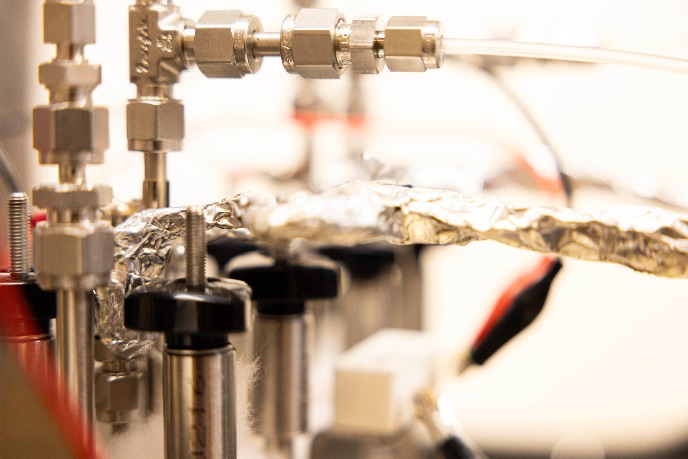We zetten vol in op waterstof. Maar zijn we daar wel klaar voor?

De beloften van groene waterstof zijn groot: het kan dienen als ‘batterij’ voor energie-opslag, we kunnen het gebruiken in de chemische industrie, en de enige uitstoot die het oplevert is wat waterdamp. Maar helaas is het momenteel nog veel goedkoper om ‘grijze’ waterstof uit aardgas te produceren, blijkt opslag van waterstof niet eenvoudig, en is het als indirect broeikasgas toch niet zo schoon als het lijkt. Daarom is er nog veel werk aan de winkel voor wetenschappers van de Rijksuniversiteit Groningen.
FSE Science Newsroom | Charlotte Vlek
Waterstof is het kleinste, simpelste element van waaruit al het andere is ontstaan. Kort na de oerknal was het universum gehuld in een mist van waterstof. En nog steeds is dit oudste element overal om ons heen, bijvoorbeeld in water (H2O), in aardgas (met als belangrijkste component methaangas, CH4), en in ammoniak (NH3).
Waterstof komt in z’n eentje eigenlijk niet voor in de natuur: het is altijd in verbinding met iets anders. Toch is het wel mogelijk om waterstof los te peuteren uit die verbindingen, zodat het op zichzelf een molecuul vormt (H2). Om dat voor elkaar te krijgen, moet je er wat energie in stoppen. Die energie komt weer vrij (met een klein beetje verlies), wanneer het waterstofmolecuul weer mag reageren met iets anders.
Groene waterstof goedkoper maken

Nu is de gedachte: als je water zou splitsen in waterstof- en zuurstofmoleculen met energie uit hernieuwbare energiebronnen, heb je als het ware een ‘groene batterij’. Wanneer de zon schijnt of de wind waait, kun je het overschot aan stroom van zonnepanelen of windmolens gebruiken om waterstof te maken. Door waterstof met zuurstof te laten reageren krijg je weer water en komt er energie vrij.
Maar op dit moment is de goedkoopste optie grijze waterstof: gemaakt uit aardgas, en met als bijproduct kooldioxide (CO2). De reden daarvoor is simpel: waterstof uit water is nu namelijk nog ongeveer vijf keer zo duur.
Daarom werken wetenschappers van de Rijksuniversiteit Groningen aan efficiënte en goedkope productie van waterstof uit water.

Omdat waterstof zich zo graag bindt aan andere elementen, zijn er nog veel meer toepassingen dan alleen de 'groene batterij': denk aan de boer die kunstmest (met ammoniak, NH3) over het land strooit, of de kapper die waterstofperoxide gebruikt om je haar te bleken. Maar ook een auto kan rijden op waterstof, en wist je dat je uit menselijke uitwerpselen waterstof kunt winnen? Wetenschappers van de RUG werken aan toepassingen van waterstof op allerlei manieren, bijvoorbeeld de transportsector en de chemische industrie.

En dan, als het lukt om goedkoop en efficiënt groene waterstof te produceren? Dan moet het ergens opgeslagen worden, of getransporteerd naar de plaats waar het nodig is. Zou het niet handig zijn als het waterstofgas simpelweg in de plaats komt van het aardgas dat we nu gebruiken: dat we het kunnen transporteren door de bestaande leidingen en dat we het zelfs zouden kunnen opslaan in de lege gasvelden onder de grond?
Maar waterstof is ook ontzettend klein, het kleinste element, en het waterstofmolecuul (H2) is veel kleiner dan aardgas. Waterstof kan ontsnappen door de kleinste kiertjes en scheurtjes. Maar erger nog: het kan andere materialen aantasten, waardoor bijvoorbeeld het metaal van een leiding of opslagtank bros wordt als glas, zodat het gemakkelijk in duizend stukjes uiteenvalt.
Daarom gaan wetenschappers van de RUG ook onderzoeken wat er eigenlijk gebeurt met de materialen waarin we waterstof willen opslaan en transporteren.

En dan blijft er nog één vraag over: we noemen het groen, maar is het ook echt groen? Waterstof uit water, gemaakt met hernieuwbare energie, dat klinkt mooi. Evenals de schone waterdamp die het zou opleveren bij gebruik. Toch is het belangrijk om goed in de gaten te houden wat er gebeurt in de atmosfeer wanneer waterstof door een scheurtje weet te ontsnappen.
Waterstof is namelijk een indirect broeikasgas: dat betekent dat waterstof zelf geen kwaad kan, maar door reacties in de atmosfeer wél. Het kan dan onder andere leiden tot meer methaangas, ozon en waterdamp hoog in de atmosfeer, wat allemaal opwarming tot gevolg heeft.
Momenteel is het niet zo erg als er hier en daar een kleine hoeveelheid waterstof lekt, maar wat als we vol inzetten op waterstof als groene oplossing? Dan wordt het des te belangrijker om goed te kunnen meten en begrijpen wat er gebeurt met waterstof in de atmosfeer, vanwege de impact op het klimaat.
Daarom meten wetenschappers van de RUG waar waterstof de atmosfeer in lekt, en bestuderen ze het effect daarvan.
Noord-Nederland is Hydrogen Valley Campus Europe . Hier hebben we jarenlange ervaring met gas, het is dé plek in Europa waar groene energie aan land komt (van windmolenparken op de Noordzee), en waar universiteiten en hogescholen en MBO’s de komende tijd gaan werken aan nieuw onderzoek én het opleiden van de volgende generatie technici voor de waterstofeconomie van de toekomst. Dit artikel is de eerste in een reeks over waterstofonderzoek aan de Faculty of Science and Engineering van de Rijksuniversiteit Groningen.
Lees alle artikelen hier:
Waterstof is een indirect broeikasgas: door reacties met andere verbindingen in de atmosfeer kan het op meerdere manieren bijdragen aan de opwarming van de aarde.
Waterstof is een veel kleiner molecuul dan aardgas en zou dus gemakkelijker kunnen ontsnappen. Maar, erger nog: waterstof, hoe klein het ook is, kan grote materialen aantasten en ze zo breekbaar maken als glas.
Hoogleraar energieomzetting Aravind Purushothaman Vellayani werkt aan systemen die waterstof gebruiken om elektriciteit te produceren. Bijvoorbeeld in grote fabrieken, maar ook je auto of zelfs je toilet kunnen elektriciteit uit waterstof produceren.
De techniek om op een duurzame manier waterstof uit water te winnen bestaat al een eeuw, maar waterstof uit aardgas halen is goedkoper. Daarom werken wetenschappers van de RUG aan technieken om groene waterstof efficiënt, betaalbaar en schaalbaar te produceren.
Meer nieuws
-
19 december 2025
Mariano Méndez ontvangt Argentijnse RAÍCES-prijs
-
18 december 2025
Waarom innoveren, en voor wie?
-
17 december 2025
Ben Feringa wint Feynmanprijs
